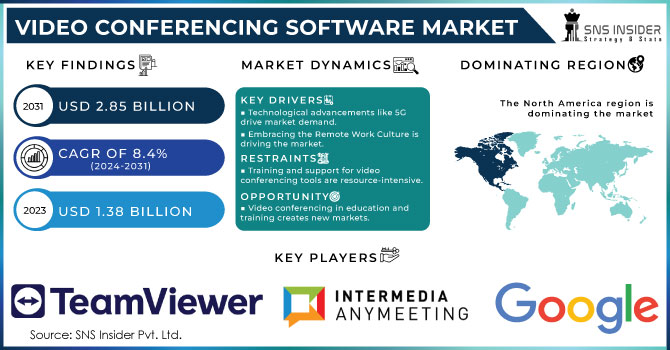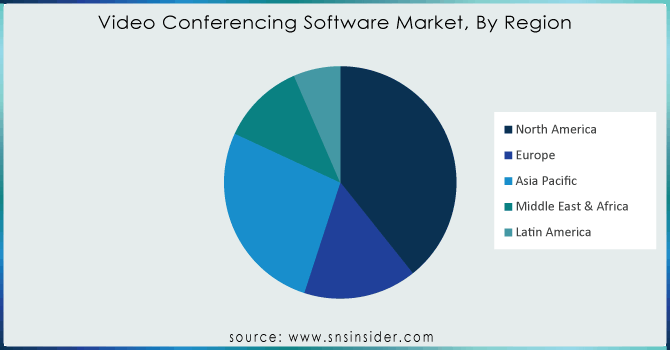Video Conferencing Software Market Report Scope & Overview:

Get more information on Video Conferencing Software Market - Request Free Sample Report
The Video Conferencing Software Market size was USD 1.38 billion in 2023 and is expected to Reach USD 2.85 billion by 2031 and grow at a CAGR of 8.4 % over the forecast period of 2024-2032.
The Global Video Conferencing Software Market is anticipated to experience significant growth in the projected period, driven by the increasing demand resulting from the widespread internet penetration and the growing usage of smartphones. Moreover, the presence of high-speed internet further accelerates the expansion of this market segment.
In order to provide a comprehensive understanding of the market, the Global Web Conferencing Software Market report offers a holistic evaluation. This report includes a thorough analysis of key segments, emerging trends, driving forces, restraining factors, competitive landscape, and other crucial factors that play a substantial role in shaping the market.
Market Dynamics
Drivers
-
Technological advancements, such as the emergence of high-speed internet connectivity like 5G, have significantly contributed to the growing market demand
-
Embracing the Remote Work Culture is driving the market.
As the world witnesses a surge in remote work arrangements, the ability to seamlessly collaborate with geographically dispersed teams has become a pressing need. Consequently, the demand for video conferencing solutions has soared to new heights. By eradicating the necessity for travel, video conferencing not only slashes expenses but also liberates precious time. This makes it an exceptionally cost-effective communication solution, catering to the needs of businesses across various industries. Video conferencing serves as a catalyst for real-time communication, empowering teams to make swift decisions, streamline project management, and ultimately amplify productivity levels.
Restrains
-
Users may require training and technical support to effectively use video conferencing tools, which can be resource-intensive for companies and service providers.
-
Poor internet connections, low bandwidth, and network congestion can hinder the quality of video calls, leading to a less satisfactory user experience.
Opportunities
-
Video conferencing enables people and businesses to connect with anyone, anywhere in the world. This global reach opens up opportunities for companies to expand their customer base and connect with partners, clients, and employees worldwide.
-
Advances in technology, such as improved video quality, better audio, augmented reality (AR), virtual reality (VR), and artificial intelligence (AI) integration, can enhance the user experience and create new opportunities for innovation.
-
Video conferencing platforms have found applications in the education and training sectors, allowing for virtual classrooms, remote learning, and online training, creating new markets and opportunities.
Challenges:
-
As video conferencing software gains popularity, it becomes a target for security threats and privacy breaches. Protecting sensitive data and ensuring the confidentiality of conversations is a significant challenge.
-
Ensuring that video conferencing software works seamlessly on various devices and operating systems can be a technical challenge. Compatibility issues may arise, which can affect the user experience.
Impact of the Russia-Ukraine
The conflict may lead to a shift in market dynamics, with companies in regions affected by the war looking for alternative technology solutions, potentially favoring software providers from more stable regions. This could impact the market share and competitive landscape.
With increasing political tensions, data security and privacy concerns may become more pronounced. Organizations may be more cautious about using video conferencing software from providers with ties to countries involved in the conflict, potentially leading to a shift in preferences. Governments could impose new regulations or restrictions on the use of video conferencing software for national security or data privacy reasons. Companies may need to adapt their products and services to comply with evolving regulatory environments. As the war and its economic consequences unfold, it may accelerate or reshape remote work trends. Organizations may rely more heavily on video conferencing as part of their remote work strategies, potentially driving the adoption of more advanced and integrated solutions. Economic instability resulting from the war could affect businesses' budgets and spending decisions, potentially impacting their investments in technology, including video conferencing software.
Impact of Recession
Recessions often lead to job losses and cost-cutting measures. This can result in a larger workforce turning to remote work, which, in turn, drives increased demand for video conferencing tools to facilitate remote collaboration. during a recession, businesses may have tighter budgets and might be more cautious about making new technology investments. They may prioritize cost-cutting in other areas, potentially impacting their willingness to purchase or upgrade video conferencing solutions. Increased demand for video conferencing may lead to intensified competition among software providers, potentially resulting in more competitive pricing and innovation to gain market share. Video conferencing software providers may adapt their products to cater to specific needs during a recession. For example, they might develop features that facilitate online training, webinars, or secure communications, depending on the market demands. Government stimulus packages and corporate initiatives aimed at supporting remote work and digital transformation can influence the video conferencing market. For example, government investments in digital infrastructure can create opportunities for video conferencing software providers.
Key Market Segmentation
By Deployment Model
-
On-premises
-
Cloud-based
By Product
-
Telepresence Video Conferencing Software
-
Integrated Video Conferencing Software
-
Desktop Video Conferencing Software
By Organization Size
-
Small and Medium Enterprises (SMEs)
-
Large Enterprises
By End-user Industry
-
Healthcare
-
Education
-
IT and Telecom
-
BFSI
-
Manufacturing
-
Retail
-
Others
Regional Analysis
In North America, the market is propelled by a 38% share with the presence of prominent technology companies, the widespread adoption of remote work practices, and the imperative for seamless communication across vast distances. Europe, too, is witnessing significant growth, fueled by the prioritization of flexible work arrangements and the surging popularity of virtual meetings.
The Asia Pacific region is experiencing rapid expansion, driven by the escalating digitization of businesses, advancements in communication infrastructure, and the necessity for cross-border collaboration. Latin America, as well as the Middle East and Africa, are also observing steady growth, propelled by increasing investments in communication technology and the growing acceptance of remote work.

Need any customization research on Video Conferencing Software Market - Enquiry Now
REGIONAL COVERAGE:
North America
-
US
-
Canada
-
Mexico
Europe
-
Eastern Europe
-
Poland
-
Romania
-
Hungary
-
Turkey
-
Rest of Eastern Europe
-
-
Western Europe
-
Germany
-
France
-
UK
-
Italy
-
Spain
-
Netherlands
-
Switzerland
-
Austria
-
Rest of Western Europe
-
Asia Pacific
-
China
-
India
-
Japan
-
South Korea
-
Vietnam
-
Singapore
-
Australia
-
Rest of Asia Pacific
Middle East & Africa
-
Middle East
-
UAE
-
Egypt
-
Saudi Arabia
-
Qatar
-
Rest of Middle East
-
-
Africa
-
Nigeria
-
South Africa
-
Rest of Africa
-
Latin America
-
Brazil
-
Argentina
-
Colombia
-
Rest of Latin America
Key Players:
The prominent players in the market are Google Inc, Citrix Systems, Anymeeting, Vsee, Teamviewer, Valisha Technologies, Logmein, Amazon Chime, Microsoft, Meetingburner, Cisco, Adobe Connect, Zoho Meeting, Brother International, Polycom Inc, Mikogo, and others in final Report.
Recent Developments:
In February 2020, Logitech International S.A., a renowned manufacturer of computer peripherals and software, introduced the Logitech StreamCam. This innovative webcam is specifically designed for content creators and streamers, offering exceptional features such as 1080p/60 fps video, USB-C connectivity, and flexible mounting options.
In July 2019, National Westminster Bank (RBS-NatWest) launched a groundbreaking video banking channel tailored for small and medium-sized enterprises (SMEs). This initiative enables organizations to conveniently arrange video calls between multiple participants and NatWest relationship managers using their mobile devices, tablets, or PCs.
| Report Attributes | Details |
| Base Year | 2023 |
| Forecast Period | 2024-2032 |
| Historical Data | 2020-2022 |
| Report Scope & Coverage | Market Size, Segments Analysis, Competitive Landscape, Regional Analysis, DROC & SWOT Analysis, Forecast Outlook |
| Key Segments | • By Deployment Model (On-premises, Cloud-based) • By Product (Telepresence Video Conferencing Software, Integrated Video Conferencing Software, Desktop Video Conferencing Software) • By Organization Size (Small and Medium Enterprises (SMEs), Large Enterprises) • By End-user Industry (Healthcare, Education, IT and Telecom, BFSI, Manufacturing, Retail, Others) |
| Regional Analysis/Coverage | North America (US, Canada, Mexico), Europe (Eastern Europe [Poland, Romania, Hungary, Turkey, Rest of Eastern Europe] Western Europe] Germany, France, UK, Italy, Spain, Netherlands, Switzerland, Austria, Rest of Western Europe]), Asia Pacific (China, India, Japan, South Korea, Vietnam, Singapore, Australia, Rest of Asia Pacific), Middle East & Africa (Middle East [UAE, Egypt, Saudi Arabia, Qatar, Rest of Middle East], Africa [Nigeria, South Africa, Rest of Africa], Latin America (Brazil, Argentina, Colombia Rest of Latin America) |
| Company Profiles | Google Inc, Citrix Systems, Anymeeting, Vsee, Teamviewer, Valisha Technologies, Logmein, Amazon Chime, Microsoft, Meetingburner, Cisco, Adobe Connect, Zoho Meeting, Brother International, Polycom Inc, Mikogo |
| Key Drivers | • Technological advancements, such as the emergence of high-speed internet connectivity like 5G, have significantly contributed to the growing market demand |
| Market Opportunities | • Video conferencing enables people and businesses to connect with anyone, anywhere in the world. This global reach opens up opportunities for companies to expand their customer base and connect with partners, clients, and employees worldwide. |

